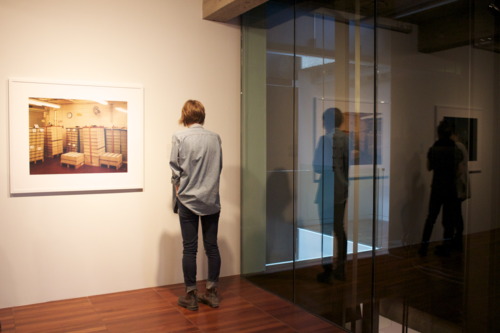The Role of Text
The Role of Text
It is interesting to observe visitors in gallery spaces. Some go straight for the wall text, wanting to know the facts before viewing the work. Others spend more time with the work itself andbreeze by the wall text, skimming the contents diagonally to capture key words. One approach is not better than the other: they simply represent different ways of viewing and responding to works of art and the text that accompanies them.

In Chronicles of a Disappearance, many people on guided visits have had quite a lot to say about the texts that appear on the walls: the content, the placement, the size, and so on. The work that first comes to mind, of course, is Taryn Simon’s An American Index of the Hidden and Unfamiliar. The wall texts that accompany each individual photograph, explaining the image and its background, are written in a minuscule text, following the artist’s specifications. It is a strategy that successfully encourages viewers to approach the works and have an intimate viewing experience, as only a few people at a time can read and view the works.
Simon’s other work in the exhibition, Zahra/Farah, poses another, more personal question. There is a warning on the wall at the entrance to the room where the work is exhibited that informs visitors about the difficult viewing experience that accompanies this work. One student on a tour that I gave last week suggested that it would be interesting to see how people reacted if the wall text explaining this work was actually placed next to the warning, outside of the gallery space. She questioned how people would react to the work if they read the contents of the text before viewing the work (since it’s position now is such that viewers have no choice but to see the photograph before making their way to the text). How would this change people’s perception and reception of the work?

From a different perspective, another student wondered about the placement of the text in Teresa Margolles’ Plancha. When conducting a guided visit of this work, I always start off by asking my group to first observe it, listen to it, to look at what is occurring, to feel the heat coming off of the metal plates, and to basically have a general experience while in the presence of the work. Slowly, I introduce the ideas behind Plancha, Margolles’ practice, her interests, and the source of the water that is dripping onto the plates. Viewers who are not part of a group visit, however, are confronted by the wall text immediately upon entering the room. The context is available to them from the start, and they have to decide if they want to read it immediately, or wait until they have really seen the work.
Perhaps it is best to leave the decision in the hands and eyes of the viewers. They are the ones, after all, who have come to the exhibition, ready to experience the work – and the text – in whichever way they are the most accustomed and in whichever way that makes them the most comfortable. It is just another way for viewers to personalize the exhibition, and make it their own.
Amanda H. Beattie
DHC/ART Education
Photos: Myriam Daguzan Bernier